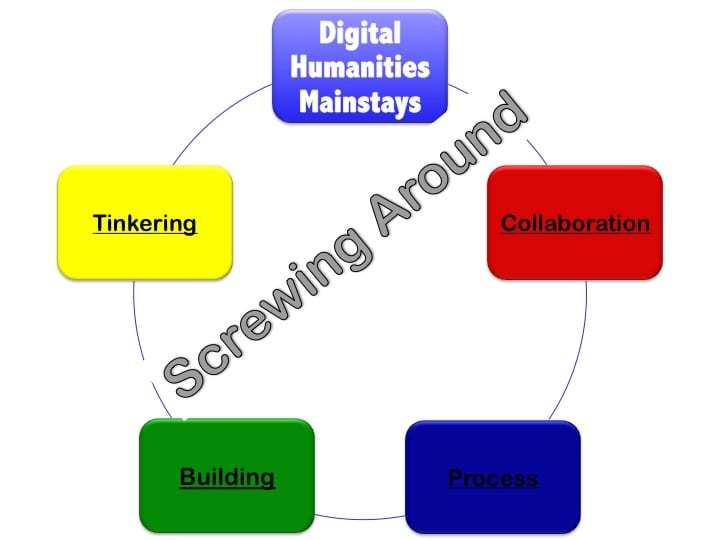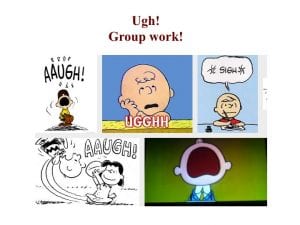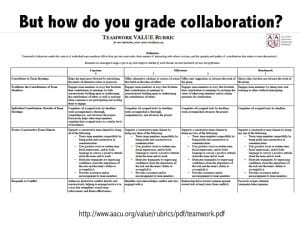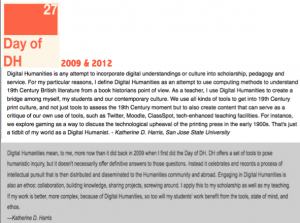
I’ve spent a lot of my career here at SJSU converting my research-oriented practices towards a more forward-facing collaboration with my students in project-centered learning environments. During my first forays into adventures with SJSU English and Composition students more than a decade ago, I taught the way that faculty had taught me at Cal State L.A. so many years ago: lectures with lots of interesting discussion centered around a novel or poem or philosophical musing. Grad school was like that, too, until I got into my dissertation area. And, I just assumed, even while teaching at multiple schools in the City University of New York system, that all students were as fascinated as I was about literature, culture, news, politics, the world. The CUNY students at Hostos Community College, Queens College, and Lehman College taught me differently, but in the throes of finishing a dissertation, living in the vibrancy of NYC, and moving across country for a job, I didn’t quite get it.
And, I didn’t quite get it when I arrived at SJSU an Assistant Professor in 2005, though I had just finished a traditional dissertation PLUS a project-based dissertation where my advisors let me roam around, ask questions, fail, and discover for myself. I hadn’t yet found a bridge to be able to facilitate that kind of learning…at least until Digital Humanities methodologies became much more transparent.
Digital Humanities is a field of inquiry positioned to pursue large questions in the Humanities in addition to providing access to inaccessible texts, and so much more. Wikipedia offers the clearest definition (and was authored by all of us Digital Humanists when it was first being formulated, debated, and discussed in 2010):
Digital humanities (DH) is an area of scholarly activity at the intersection of computing or digital technologies and the disciplines of the humanities. It includes the systematic use of digital resources in the humanities, as well as the reflection on their application.[1][2] DH can be defined as new ways of doing scholarship that involve collaborative, transdisciplinary, and computationally engaged research, teaching, and publishing.[3] It brings digital tools and methods to the study of the humanities with the recognition that the printed word is no longer the main medium for knowledge production and distribution.[3]
By producing and using new applications and techniques, DH makes new kinds of teaching and research possible, while at the same time studying and critiquing how these impact cultural heritage and digital culture.[2]Thus, a distinctive feature of DH is its cultivation of a two-way relationship between the humanities and the digital: the field both employs technology in the pursuit of humanities research and subjects technology to humanistic questioning and interrogation, often simultaneously.
Teaching these strategies while also providing full coverage for literature 1775-present was daunting because I would have to excise some literature in order to teach students how to use the digital tools, which, at that time, included blogging and other low-barrier entries into digital media uses. Through the years, I altered my view of Digital Humanities to suit SJSU’s mission statement.
What skills would digital tools afford them to learn in order to further their critical inquiry into the literature and literary historical periods?
After 8 years of toying around, I finally hit upon a pedagogy that married my praxis to the expectations for coverage and pedagogy at SJSU and, then, authored an article which grounds my theories about teaching at this particular institution and highlights my commitment to my students, my university, my Digital Humanities point of view: “Play, Collaborate, Break, Build, Share: ‘Screwing Around’ in Digital Pedagogy.” 3:3 (Fall 2013) Polymath Special Edition on “Doing Digital Pedagogy at a Non-R1.”
Because publishing about teaching and learning scholarship in journals can’t match the speed with which we must be creative in our pedagogy at SJSU, I often blog about innovative pedagogy, student projects, and more over on TriProfTri, including a recent post “Sample Assignments for Project-Based Literature Courses.”
In recent conversations with colleagues across campus, I’ve been attempting to distill this pedagogy down to a few simple ideas that anyone can integrate no matter the discipline while also working on how to share the actual “stuff” of teaching — assignments, rubrics, syllabi, tools. For the past 8 years, I’ve been working on a collection of that teaching “stuff” as an editor of Digital Pedagogy in the Humanities: a collection of pedagogical artifacts organized by keywords, each defined by a “curator” who then curates and annotates10 pedagogical artifacts to demonstrate teaching those concepts through digital methods. The project, which has been/will be completely open access to anyone, is currently available in the post-peer review GitHub repository awaiting its conversion into the new digital platform being built by our publisher, the Modern Language Association.
Jennifer Redd generously offered a space to blog about some of those Digital Pedagogy ideas this semester here in the eCampus space.
Here’s our first idea:
How do you teach project-based learning and collaboration?
This leads to our campus-wide initiative of late:
Can project-based learning incorporate faculty research goals? How?
In my field, recovery of inaccessible texts allows my courses to move beyond the traditional literary canon (of mostly white-male dominated writing). There’s an exponential number of 19th-century periodicals, journals, newspapers, poetry volumes, or novels. While Google Books, The Internet Archive, and HathiTrust have gone a long way towards providing free access to some of these “missing” texts, how do we teach students the research and then critical analysis skills to articulate these texts in conversation with the 19th-century literary canon? And, then, how do we facilitate, for instance, a digital exhibit or edition of these visual-heavy texts?
It’s a daunting endeavor, especially when teaching a 4-4 or even a 3-3 load.
The first step is not the tools, but instead to re-evaluate students as “learners.”
The next step is articulating a collaborative environment and meeting that student resistance with a cognitive revision away from “group work” (divide and conquer) … …into “teamwork” (an environment that enhances an idea of ticking off the assignment requirements).
…into “teamwork” (an environment that enhances an idea of ticking off the assignment requirements).
…then, we offer then a different learning style
My adventures in implementing this teaching strategy, began in earnest in 2012 when I taught my first course in Digital Humanities in my Department. In Fall 2012, I wrote an excited post about Digital Humanities courses having been approved in my Department. One course didn’t make due to low enrollment, but the other course, the graduate course, went forward in Spring 2013. These 10 intrepid graduate students allowed me to experiment with them throughout the semester.
In Spring 2013, my department allowed me to teach a graduate seminar in Digital Humanities under the guise of Special Topics in Contemporary Theory. We threw out the syllabus on the first day because, quite frankly, I was bored of teaching Intro to Digital Humanities. Instead, I wanted them to make something, but they would have to get through the theory, define the project, educate themselves on history of the book and literary history topics, and grapple with issues of technology in a completely unfunded digital project. This, of course, made some of my colleagues anxious; but, I needed to see how this would work with our particular kinds of students.
- Would they be interested in this type of collaborative, process-driven work?
- Would they be engaged enough to drive the semester? It was certainly a bit scary for me and there are some changes that I will make for the next instantiation of this course, but overall, I was pleased.
…and then I was even more pleased.
At the conclusion of the semester, after writing a proposal for a Digital Humanities Center and drawing up the plans for the next version of this course, the students decided that a proper history of the project needed to be published in a peer-reviewed journal. A draft was put together and submitted to the Journal of Interactive Technology and Pedagogy because it focuses on DH and pedagogy in a way that other journals do not. We asked the editors to consider this a special type of article, one that highlights the student perspective in DH projects — not as trained monkeys, but those who are making decisions about a public project, not a one-off class project. Then it got difficult. Everyone scattered at the conclusion of the semester. But, three intrepid grad students stayed the course and worked with the JITP editors to create a history of this project that included all of the variables and tribulations of the decision-making process, including the materials unearthed by the original students who worked on the project for a year without academic credit or recognition. These original Beardstairs (as we call them), went to conferences, applied for university award, and generally performed DIY or guerilla DH. The Beardstair graduate course was a step towards codifying DH projects into our graduate curriculum. Students would get credit for this screwing around.
What was the result?
Yep. A peer-reviewed article in a well-known, widely read online journal.
“BeardStair: A Student-Run Digital Humanities Project History, Fall 2011 to May 16, 2013” by David T. Coad, Kelly Curtis, and Jonathan Cook with contributions by Valerie Cruz, Dylan Grozdanich, Randy Holaday, Amanda Kolstad, Alexander James Papoulias, Ilyssa Russ, Genevieve Sanvictores, Erik White and the original Beardstair team who worked on the project out of joy instead of academic credit, Jesus Espinoza (BA English), Colette Hayes (MLIS School of Library and Information Science student), Doll Piccotto (MA English), and Pollyanna Macchiano (BA English).
How did we accomplish this?
Where is the digital scholarly edition that was promised?
Is this FAILURE?!
We were unconventional during the semester because it was the first instantiation of an introductory seminar in Digital Humanities in the graduate program that would afford a project-based environment. Instead, we broke the project and the semester into phases: research, development, building, and publication. By the building phase of the semester, we had decided on goals (both dream and realistic), dispensed with the normal grading scheme, ditched formal assignments, and added readings where the need arose from the previous week’s discussion. During this phase, we also used class time as project management sessions.
I took a very unconventional approach to grading and weekly writing. They kept a blog, but more importantly, they kept group blogs to demonstrate collaboration (something that’s extremely difficult to document). We ran into a snag with resources towards the beginning of the building phase, and it became apparent that it would be difficult to complete the project goals by semester’s end due to lack of IT resources on campus. We mulled over “Published Yet Never Done” in Digital Humanities Quarterly and revised our goals to reach a satisfactory collaborative benchmark for being “done” this semester. (And they collaborated with other grad students, including Matt Kirschenbaum’s students in University of Maryland.)
To satisfy the grading requirement for this semester, they assessed each other based on an extensive teamwork rubric. They already had a practice run at this so I could norm them to the process. At that point, each working group also had a frank conversation about each member’s working habits. That fixed some issues in one working group while highlighting the successful collaboration in another group.
I know I was doing some unconventional things with this course that might seem strange, but I wanted a chance to experiment with the course and pedagogical praxis. The students were all up for the challenge and have continued to be engaged in the material and the production. I also learned how we can do DH in our curriculum and with our limited resources. It won’t be as grand a version of DH as at Stanford, but I think we can do it if we scale back.
As a last reflection, I asked each of the participants to write a reflective post that ruminated on the success/failure of fulfilling the department’s student learning goals. A majority of the posts listed successes, but a few listed the failures – and this is where it was important to listen. One student noted that “collaboration” we practiced wasn’t the type that he had learned. He was looking for more discussion, more open dialogue about the raw materials. And, at some point, he became so frustrated that he stopped speaking up in the big group. Fair enough! We chatted about this at the conclusion of our last class; and it was at that point that others noted this difference too.
They all suggested during this meeting that the next instantiation of Beardstair, or any other DH course, should begin with lab sessions to learn HTML and then TEI (both mark-up languages used to generated text in a web page). They requested to learn these practical skills! Since then, I have integrated Lab Reports as assignments to report out on the acquisition of skills or knowledge.
Ideally, we would have completed the entire project and produced a digital scholarly edition. But early on, we noted that other than Omeka (and potentially Scalar), there are no out-of-the box platforms for producing a robust digital edition, at least not in the way that they wanted to visually represent these books. We also couldn’t get server space at SJSU, so one student (without informing me beforehand) purchased a domain name for a year for our use to experiment with some emerging digital tools out in beta.
The lengthy discussion that chased us all semester was about the underlying use of tools –
the tools signal an argument about the digital reconstruction of these 3 livre d’artiste books
In the class blog, students posted jointly and individually; I posted about pedagogy. But each week represents a list of tasks – it’s our raw working documents. Their struggles to articulate theory and assess the material object reflect the struggles we have in Digital Humanities at large. We added the task of writing a funding proposal for a Digital Humanities Center here at SJSU, complete with a list of required resources and cross-disciplinary collaborations.
And, finally, the participants decided that we needed something to mark the intellectual thought process of the semester – all of that stuff that often goes into the making any edition, the stuff that’s invisible. They submitted an article about the process to the Journal of Interactive Technology and Pedagogy and wanted to submit a portion of the edition to Scholarly Editing.
They were struck by this idea of “completion” and failure.
What makes for a successful DH project?
Well, for this semester, that we didn’t complete the TEI mark-up and Omeka representations of The Sphinx by Oscar Wilde (1920 edition), Sebastian Van Storck written by Walter Pater and Illustrated by Alastair (1927), and The Ballad of a Barber by Aubrey Beardsley (1919 edition) wasn’t such a failure. And, if it was in the eyes of the departmental learning goals, then maybe it’s time that we revise our learning goals.
How do I get into this project-based learning?
or incorporate my students into my research agenda?
We have a terrific new initiative at SJSU: Excellence in Engaged Learning (Excel) with several workshops that were offered in Fall 2018 (and the slides) available on their website.
ECampus is also offering an opportunity to engage in Active Learning strategies through a series of workshops. With the Spring 2019 cohort now set, we’re looking forward to hearing from these faculty participants about their adventures.


